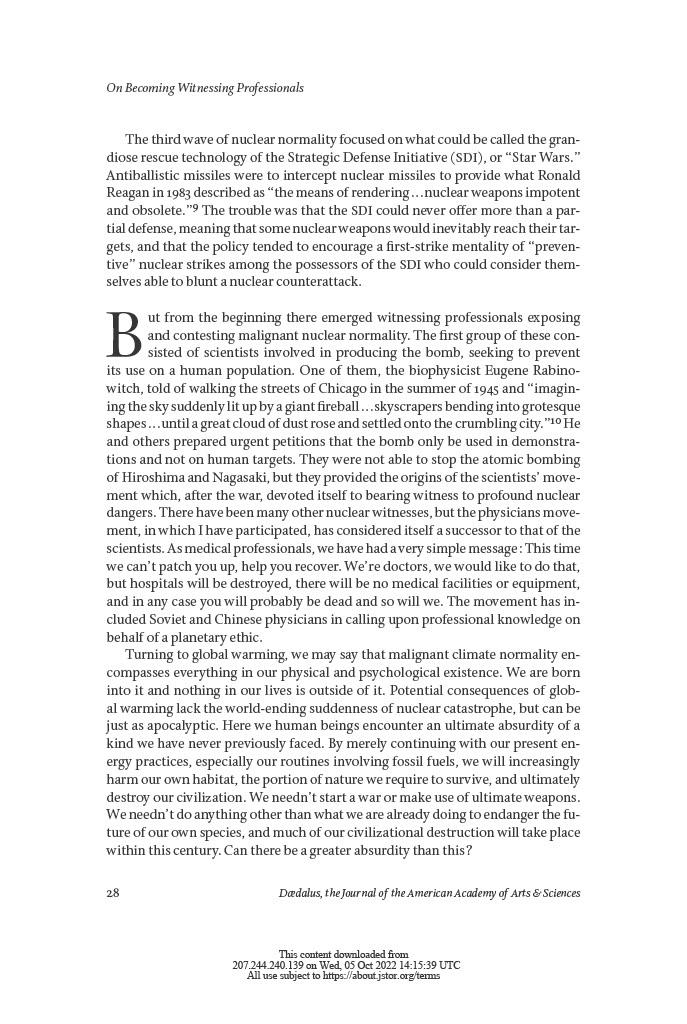The Source’s Purpose
Robert Jay Lifton offers an account of his experiences conducting systematic interviews with Hiroshima bombing survivors or hibakusha in the early 1960s and his reflections. The work is reminiscent of a descriptive scientific essay with the elements of external research rather than a research article with a clear methodology since the author’s writing pursues various purposes simultaneously (see Appendix). Such communicative goals include reflecting on the Hiroshima study’s role in anatomizing atomic bombings’ after-effects on people and habitats and explaining the “malignant mortality” concept and its three waves (Lifton 26). Additionally, using the history of atomic bombs’ representations in the media, Lifton describes the scientific community’s quest for searching the psychological/neuropsychological explanations for the normalization of radioactive weapons (29). Therefore, apart from touching upon radiation’s effects on people in Hiroshima, the source addresses the tragedy’s large-scale ethical implications.
The Discussion of Main Points
The first key point refers to Hiroshima survivors’ intense fear of losing vegetation in their habitat, thus having to deal with starvation. As Lifton recollects, the threat of losing the integrity of “the Hiroshima habitat” and the city’s ability “to sustain vegetation” affected Hiroshima survivors to a large extent, causing the spread of rumors (25). The author seems to take a neutral position to balance human feelings and established facts. Out of compassion, he openly acknowledges survivors’ feelings and the Hiroshima atomic bombing’s status as “the most extreme kind of destructive event” (Lifton 26). However, to refrain from distorting factual information, the author clearly refers to such allegations as rumors as the worst environment-related expectations did not turn out to be completely accurate.
The author’s second crucial point is that malignant normality (MN) caused the U.S. to perceive the use of nuclear weapons in Hiroshima as the available form of defending national security. Keeping track of the history of MN in Nazi Germany and then the U.S., Lifton seems to suggest that decision-makers involved in the bombing of Hiroshima had distorted perceptions of reality (26). In this argument, the author seeks to create an impression of neutrality, but his argument might indeed be favorable to the American side. Specifically, he focuses on the idea of brainwashing the nation to position nuclear weapons as suitable means for achieving national security (Lifton 27). The author fails to focus on radiation’s devastating health effects for Hiroshima survivors, including debilitating disorders, malignant tumors, acute radiation syndrome, and birth anomalies, for instance, disproportionately small heads in newborns (Tomonaga 491). To some degree, this approach to placing accents could be used to shift the blame from the aggressor to error-producing aspects of mass psychology.
The third point for discussion is that scientists and medical professionals could envision the A-bomb’s and radiation’s effects on people in Hiroshima, but their decision-making power was overly small to prevent the tragedy. As Lifton explains, those involved in producing the A-bomb and doctors became the first critiques of normalizing the nuclear war idea and petitioned for limiting the weapon’s uses only to demonstrational purposes (28). As scientists and healthcare specialists, they could not be unaware of radiation’s effects on the human body. However, their voices on the global political stage were not strong enough to call the U.S. to take a more ethical approach to war (Lifton 28). Lifton is among the physicians in the anti-nuclear-war movement, which explains that he favors the movement’s position despite seeking to report the events from a neutral standpoint (28). Nevertheless, the argument does not elaborate on the state of knowledge regarding radiation’s health impacts at that moment.
The fourth point is that intentional misinformation on radiation’s effects and mechanisms of action was strong in the U.S. That was probably meant to make the nation less sensitive to the attack’s effects on Hiroshima citizens. Specifically, according to Lifton, the so-called “duck-and-cover drills” were actively implemented to make children believe that hiding under desks or covering their heads with paper could provide adequate protection against nuclear fallout (27). The author is obviously unfavorable of educational events aimed at distorting the younger generation’s perceptions of danger.
Conclusion/Summary
In summary, the article provides an extensive overview of nuclear war normalization rhetoric in the U.S. before and after the bombing of Hiroshima and the bombing survivors’ vegetation-related concerns. The author expands on radiation’s supposed effects on Hiroshima citizens by destroying trees and plants, the promotion of MN, and scientists’ unsuccessful attempts to prevent death and suffering in Hiroshima. The article’s relevance to the course is clear from its discussion of radiation protection education in the U.S. For instance, class topics have touched upon radiation safety education for product consumers. The article views the radiation education topic from a more global perspective to illustrate how political purposes and propaganda interfere with the quality of information on self-protection during encounters with radioactive materials. In other words, despite focusing on war rather than consumer products, it reveals political goals’ role in shaping people’s perceptions of radiation protection.
Takeaways
I learned various historical facts regarding the bombing of Hiroshima and socio-political processes in the U.S. surrounding the authorization of nuclear weapons for use in human targets. Specifically, I encountered the concept of MN and the three stages of its development in the U.S., including the work with young school students. Additionally, I learned about the debate over radiation’s long-term effects on trees and plants in nuclear blast areas, including Hiroshima, and its supposed influences on people. Finally, the source encouraged me to explore the ethical aspects of radiation education.
Works Cited
Lifton, Robert Jay. “On Becoming Witnessing Professionals.” Daedalus, vol. 149, no. 4, 2020, pp. 25-32, Web.
Tomonaga, Masao. “The Atomic Bombings of Hiroshima and Nagasaki: A Summary of the Human Consequences, 1945-2018, and Lessons for Homo Sapiens to End the Nuclear Weapon Age.” Journal for Peace and Nuclear Disarmament, vol. 2, no. 2, 2019, pp. 491-517, Web.
Appendix
This appendix section provides a photocopy of the reviewed article.








